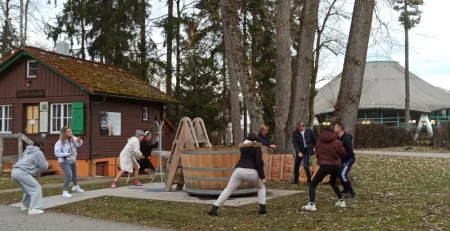It is often said that cold plunging has many positive aspects, and this is true. The benefits of cold plunging for body and mind are scientifically proven and incredibly complex. Nevertheless, there are also some risks, but these can be minimized if you are aware of them, know your limits, and approach cold plunging responsibly.
Cold Plunging
Cold Plunging Is Safest in a Group
Especially if you are a beginner, you are better protected in a group with experienced cold plungers and can avoid unnecessary mistakes. You can learn from the experience of others, and if something should happen, help is never far away. What’s more, it’s simply more fun in a group!

But now to the risks. We have divided them into two categories – frequent risks and rare risks. The frequent risks usually occur more often, but are not as serious as the rarer risks.
Common Risks When Cold Plunging
Hypothermia
Hypothermia is also known as “hypothermia” and occurs when a person’s body temperature falls below 35 degrees Celsius. This is probably not so much a mistake made by beginners, but rather by advanced cold water swimmers who overestimate themselves and stay in the ice-cold water too long, or want to break some kind of record. As hypothermia is already apparent in the cold plunge, you should get out at the latest when you start to shiver or when you feel severe pain, e.g., in your fingertips or feet. It is important to warm up slowly.
We have written an article on how long a cold plunge should take.
Slight Frostbite
Frostbite is damage to the skin and, in extreme cases, to the underlying tissue caused by extreme cold. Permanent damage can also occur, especially if exposure to cold is too prolonged (see hypothermia). Frostbite manifests itself as pain, numbness, tingling, or burning. Blisters or wounds can also develop (see picture below), which are reminiscent of sunburn. These are particularly common on hands and feet, as the blood is pumped to the center of the body during cold plunging, and extremities are less supplied with blood. Here too, slow warming is essential for a good recovery.

Skin Irritation
Cold skin irritation is a common reaction to cold exposure and can cause a variety of symptoms. The most common symptoms of skin irritation from cold include redness, pain, itching, burning, and numbness. These symptoms can occur when the skin is exposed to cold temperatures for long periods of time or when the skin goes from warm to cold weather too quickly. Chilblains can also develop as a result.

Chilblains are painful, red, itchy, or burning lesions that appear on the skin when it is exposed to cold temperatures for long periods of time. They also usually appear on the hands, feet, ears, and nose.
Another skin irritation can be triggered by cold allergy, known as cold urticaria. It is an allergic reaction to cold that leads to an itchy and burning skin rash. Cold urticaria can also lead to swelling and hives. This usually subsides completely within a few days.
Headache
Immersion in extremely cold water, as is the case with cold plunging, can also trigger headaches. The exact cause of this is not always known, but it is thought to be caused by the changes in blood flow in the brain due to the cold. Another possibility is that it is caused by the contraction of blood vessels in the head and neck muscles. Headaches after winter bathing can also be caused by the associated stress and tension. However, this decreases with experience. The more often you are exposed to the cold, the more your body will adapt to the situation and the fewer headaches you will get. After all, exposure to the cold even helps reduce migraines.
Breathing Problems
The cold air can irritate the airways, especially if you breathe in and out quickly. This is the case with breathing exercises before cold plunging. This can cause symptoms such as coughing, wheezing, chest tightness, and shortness of breath.

Hyperventilation can also occur during a cold plunge. Hyperventilation occurs due to various causes, including anxiety, stress, physical exertion, high altitude, lung or heart problems, or other medical conditions. Hyperventilation means that you breathe faster and deeper than you normally should. This can be controlled through a breathing exercise such as Wim-Hof Tummo breathing, which is good. But it can also be uncontrolled by triggering a cold reaction in your body that puts you under stress. Your body’s natural response is to gasp for breath. Hyperventilation is usually harmless and subsides within seconds or a few minutes.
Fall Injuries
Walking on slippery ice or on smooth stones in streams, rivers, and lakes is predestined to cause fall injuries ranging from bruises to broken bones. There are good neoprene shoes that give you more stability. If you find it difficult to get in, choose easy entrances. These are usually available in lakes, where there are sometimes jetties with steps or beaches with gently sloping banks. Rivers and streams are more difficult to access and sometimes have strong currents that make it more difficult for ice bathers and can lead to falls or drifting.
Exhaustion
Cold plunging is physically strenuous, especially if it is done over a longer period of time or in very cold water. When the body cools down considerably, there is an increased strain on the cardiovascular system to maintain body temperature. This leads to increased energy consumption and, depending on the type, a feeling of exhaustion or tiredness. In addition, immersion in very cold water causes shock due to the abrupt change in body temperature. This, in turn, increases levels of the stress hormone adrenaline, which also uses up energy and contributes to a feeling of exhaustion. You can read more about the release of hormones during a cold plunge here.
Rare Risks When Cold Plunging
Raynaud’s Syndrome
Raynaud’s syndrome is a condition characterized by a temporary narrowing of the blood vessels in the fingers and toes. This leads to poorer blood circulation in the affected parts of the body and sometimes also causes pain. The cause of Raynaud’s syndrome is not fully understood, but it is thought that the body reacts excessively to exposure to cold and the associated stress. Raynaud’s syndrome occurs more frequently in women than in men
The symptoms of Raynaud’s syndrome are divided into three stages:
- In stage 1, the affected areas become white and numb.
- In the 2nd stage, the skin becomes bluish and pain may occur, but it can be completely painless.
- In the 3rd stage, the affected areas regain blood flow and pinkness, and the affected areas of the body return to their original color.

Many cold plungers say this is harmless. One way to prevent it is to simply avoid the factors that contributed to the triggering. In the above case with the finger, neoprene gloves may also help, which minimize the cold exposure of the body part.
Heart Attack
A heart attack occurs when part of the heart muscle dies due to insufficient blood flow or lack of oxygen. Typical symptoms of a heart attack are pain or pressure in the chest that lasts longer than a few minutes. However, pain can also occur in other parts of the body, such as the arms, shoulders, neck, jaw, or back, which can also indicate a heart attack. You should reduce this risk as much as possible before taking a cold plunge, as it is, of course, life-threatening to suffer a heart attack. If you have any concerns or problems in your family, you should have yourself thoroughly checked by a doctor before you go into a cold plunge. It is advisable to enter the water quickly so that the blood vessels do not constrict too quickly and allow blood flow, but you should never jump into ice-cold water as the risk of shock is too high.
Sore Muscles
Sore muscles are caused by small tears in the muscle fibers and the associated inflammatory reactions. Immersion in cold water can lead to sore muscles, especially if the person is untrained or does not warm up beforehand. Muscle soreness is usually not serious and can be treated with rest, light stretching, and gentle massage.
Nausea and Vomiting
In rare cases, cold plunging or cold water swimming can also lead to nausea and vomiting. Again, this is probably more of a defensive reaction of the body to the strong tension during the cold plunge and occurs rather rarely, and if so, then rather at the beginning.
Weakening of the Immune System
There is a risk that cold plunging will weaken your immune system, especially if it is done too often or if the person already has a weakened immune system. So if you are ill, you should not go into icy cold water, because this additional strain is not beneficial, just as it is not advisable to exercise during illness.
Talk to Your Doctor Beforehand
It is important to note that cold water swimming is not suitable for everyone and should be done safely. People who suffer from certain health problems, such as heart problems, high blood pressure, or diabetes, should discuss this with their doctor beforehand and refrain from such activities if necessary. In addition, cold plunging should never be done alone and should always be done under the supervision of experienced people or lifeguards.










Leave a Reply